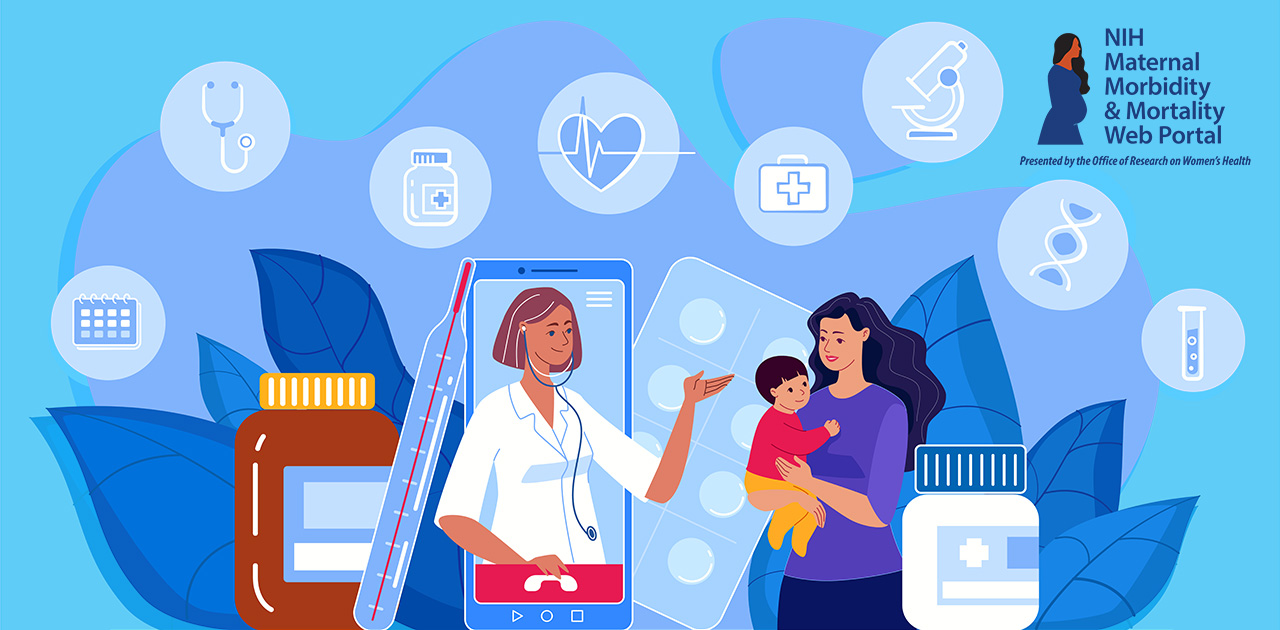A Big Boost to Federal Efforts to Reduce and Prevent
Maternal Morbidity and Mortality
White House Issues a “Call to Action”
By Dr. Janine A. Clayton
 On December 7, the White House Maternal Health Call to Action Summit demonstrated the Biden–Harris administration’s commitment to improving maternal health and reducing health disparities. An array of proposed policy changes and investments from the U.S. Department of Health and Human Services (HHS) would help support safe pregnancies and healthy babies across the Nation. The Build Back Better Act, passed by the House of Representatives and being debated in the Senate, includes a historic $3 billion investment in maternal health care. The administration adds valuable momentum to efforts to reduce maternal morbidity and mortality (MMM) as it proposes the establishment of a “Birthing-Friendly” hospital designation and issues guidance to States on how to provide Medicaid coverage for a full year postpartum. In fact, a new study from the HHS Office of the Assistant Secretary for Planning and Evaluation estimates that 720,000 more people could gain postpartum coverage if all States were to follow the new guidance and extend pregnancy-related Medicaid eligibility to 12 months postpartum.
On December 7, the White House Maternal Health Call to Action Summit demonstrated the Biden–Harris administration’s commitment to improving maternal health and reducing health disparities. An array of proposed policy changes and investments from the U.S. Department of Health and Human Services (HHS) would help support safe pregnancies and healthy babies across the Nation. The Build Back Better Act, passed by the House of Representatives and being debated in the Senate, includes a historic $3 billion investment in maternal health care. The administration adds valuable momentum to efforts to reduce maternal morbidity and mortality (MMM) as it proposes the establishment of a “Birthing-Friendly” hospital designation and issues guidance to States on how to provide Medicaid coverage for a full year postpartum. In fact, a new study from the HHS Office of the Assistant Secretary for Planning and Evaluation estimates that 720,000 more people could gain postpartum coverage if all States were to follow the new guidance and extend pregnancy-related Medicaid eligibility to 12 months postpartum.
Other promising news that was part of yesterday's White House Maternal Health Day of Action includes:
- The Eunice Kennedy Shriver National Institute of Child Health and Human Development (NICHD) announced the winners of its Decoding Maternal Morbidity Data Challenge. Identifying risks for adverse pregnancy outcomes in people who are pregnant for the first time is difficult because there is no prior pregnancy for comparison. The prizewinners proposed new methods for early detection of risks. I look forward to learning more about the winning algorithms, all of which analyzed data from the NIH-funded Nulliparous Pregnancy Outcomes Study: Monitoring Mothers-to-Be (nuMoM2b), a racially, ethnically, and geographically diverse sample of people who are pregnant for the first time.
- The National Institute of Biomedical Imaging and Bioengineering (NIBIB) announced the NIH Technology Accelerator Challenge (NTAC): Maternal Health. The competition, which is offering up to $1 million in cash prizes, will drive and reward the development of low-cost point-of-care technologies that can aid clinical decision-making, improve patient outcomes, and ultimately prevent maternal morbidity and mortality. A free informational webinar provides an opportunity to learn more about the challenge.
Approximately 700 women die in the U.S. each year because of pregnancy or delivery complications, but an estimated 3 in 5 of those deaths are preventable. Another 50,000 women experience a “near miss” with maternal death, some of which leave long-term health consequences. The Centers for Disease Control and Prevention (CDC) estimates that Black women are three times more likely to die from a pregnancy-related cause than White women. Women living in rural areas and women over age 35 are also at greater risk. Despite spending more than any other country on maternity care, the U.S. has the highest maternal mortality rate among high-income countries. But it doesn’t have to be this way. And with increased attention, solutions could be soon at hand.
Updated ORWH MMM Web Portal Provides Opportunities to Stay Informed of Latest Research
In support of efforts to improve maternal health, ORWH has enhanced the NIH Maternal Morbidity and Mortality Web Portal to improve the user experience and provide additional resources. Last year, NIH spent an estimated $224 million in research funding to prevent maternal morbidity and mortality. The portal offers links to ongoing studies and funding opportunities. An expanded “Maternal Health Across NIH” page provides a high-level view of various NIH Institutes’ and Centers’ interests and efforts related to maternal health research.

Robust Efforts Across Federal Entities Support Maternal Health
Across NIH and other Federal agencies, work is underway to learn from incidents of MMM, enhance the quality and safety of maternity care, and improve the health of women across the life course. To reach these goals, a wide variety of tactics come into play, such as research awards, prize competitions, professional forums, and educational materials. Here’s a sample of several recent and upcoming efforts:
- On January 18, 2022, NIBIB and partners will offer a virtual workshop, “Technology to Improve Maternal Health,” as part of the NIH Implementing a Maternal health and PRegnancy Outcomes Vision for Everyone (IMPROVE) initiative. The workshop aims to advance interdisciplinary collaborations in maternal health technology by bringing together researchers, technology developers, and community partners to identify technology gaps and consider new technologies. The workshop is an activity of the NIH Maternal Mortality Task Force, which supports research to reduce preventable causes of maternal deaths and improve health for birthing people before, during, and after delivery.
- The Centers of Biomedical Research Excellence (COBRE) support the establishment and development of innovative, state-of-the-art biomedical and behavioral research centers in Institutional Development Award (IDeA)–eligible States. Several IDeA States have some of the highest maternal and infant mortality rates in the United States, and ORWH has partnered with the National Institute of General Medical Sciences to create the first COBRE to support an award that advances women’s health research and expands research capacity in this area. This effort builds upon administrative supplements (NOT-GM-20-017, NOT-GM-21-018) that have expanded research and research capacity in the IDeA States to address important issues of women’s health across the lifespan.
- The HHS Office on Women’s Health’s (OWH) Racial Equity in Postpartum Care Challenge is spurring the development of innovative strategies to improve postpartum care for Black or African American and American Indian/Alaska Native women enrolled in Medicaid or the Children’s Health Insurance Program. The competition emphasizes follow-up care for diabetes, postpartum depression, postpartum anxiety, hypertension, and substance use disorders. The total cash prize of the competition is $1.8 million, and its deadline is January 31, 2022.
- OWH is also leading a national competition to identify effective, existing programs that care for people with hypertension where the programs could be or are already applied to hypertension during pregnancy and/or postpartum.
- The Health Resources and Services Administration announced the final winner of its Remote Pregnancy Monitoring Challenge. These technology-based solutions will help women make informed decisions about their care and help providers monitor the health of pregnant people.
- CDC’s Hear Her campaign has educational resources available in more than a dozen languages. Materials include guides for pregnant people and postpartum people on warning signs and sharing concerns with a health care provider; advice for their partners, family, and friends on offering support; and posters and palm cards on symptoms to be concerned about. Hear Her also has microsites and shareable content, including social media posts and graphics.
Promising Plans for 2022 and Onward
Rates of MMM in the United States are not immutable. Work to understand the women most affected, the communities they live in, and the gap between their needs and current access to quality health care and technology will go a long way toward addressing the root causes of MMM. Education for health care providers, pregnant people, and those who care about them provides a necessary layer of support to improve maternal health.
ORWH views maternal health from a multisystem, or head-to-toe, perspective. From brain (peripartum depression) to heart (cardiomyopathy) to multisystem (gestational diabetes) conditions, all aspects of maternal health should be considered through an integrated life-course lens. Likewise, efforts to improve maternal health rely on research to be evidence-based, can boost the implementation of technology and interventions, and increase educational opportunities for pregnant women, their friends and families, and their health care providers.
Just as pregnancy can be a pivotal time in health, the White House efforts bring additional momentum, leadership, and cooperation to address and improve MMM. Although work remains to be done, I am eager to see the results of all the efforts underway.
